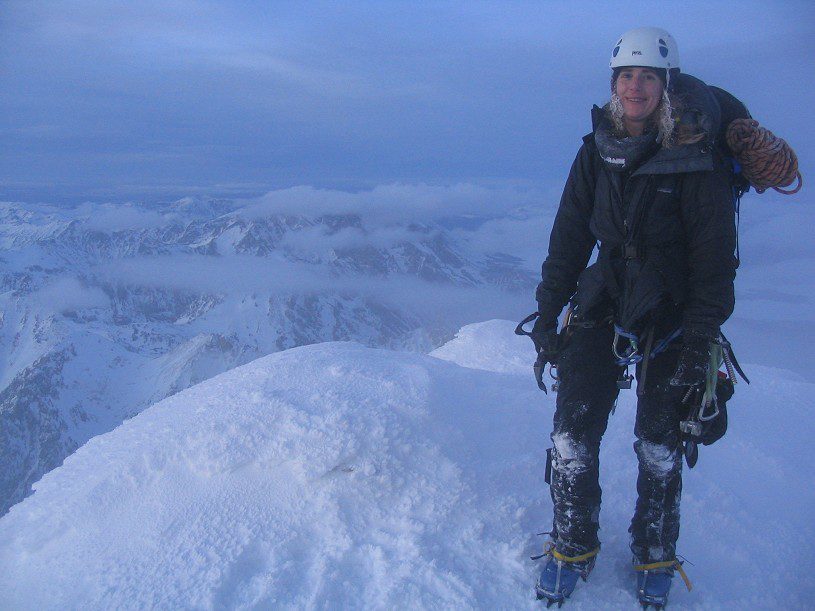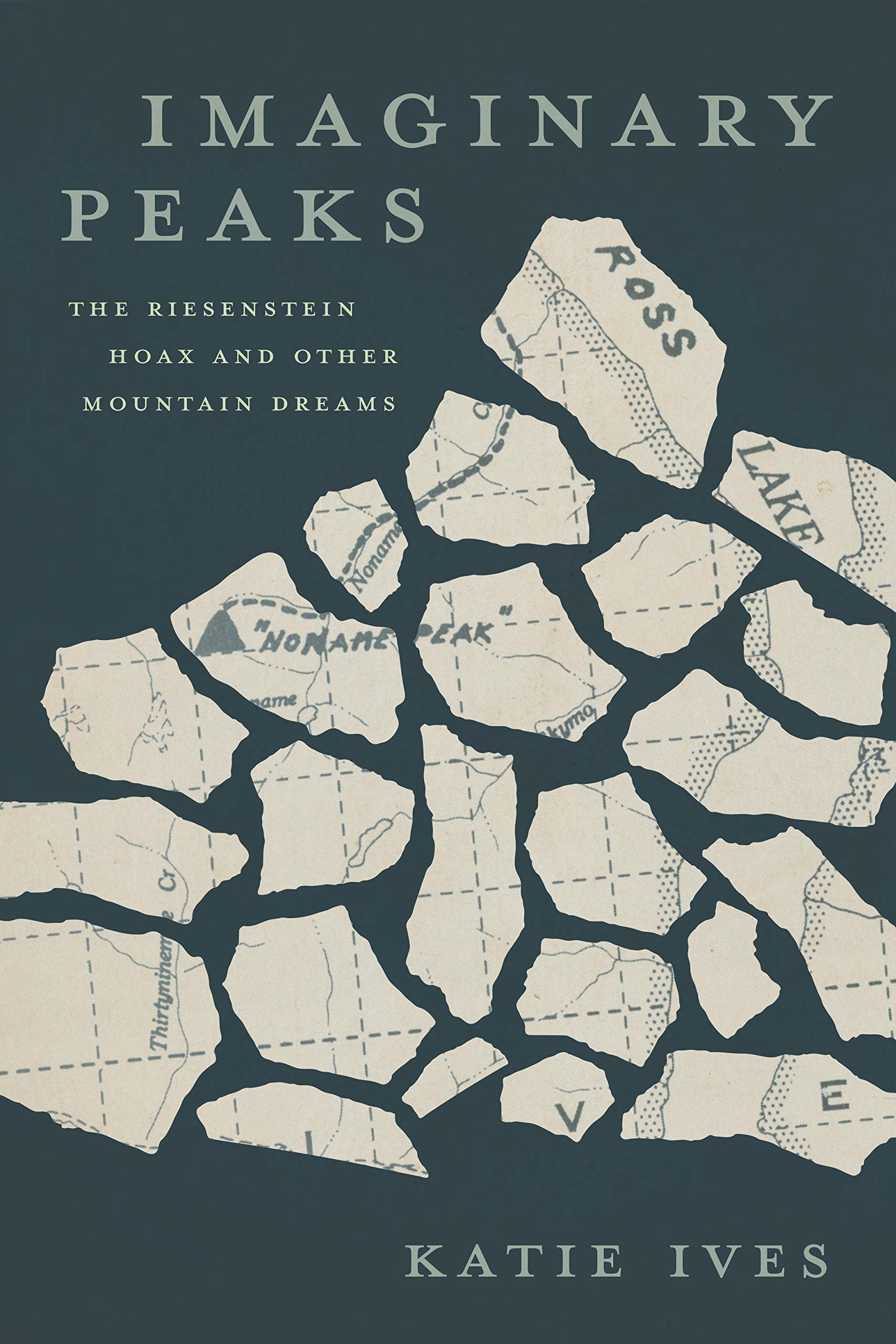Imaginary Mountains Melds Real and Fictitious Landscapes
Canadian Rockies-based author Lynn Martel reviews a book by American writer Katie Ives

A few sentences were all it took to spark Katie Ives’ interest – and the idea for her own book, Imaginary Peaks. “It really started out with a simple anecdote about the Riesenstein Hoax I read in Andy Selters’ book, Ways to the Sky,” Ives said.
The Riesenstein Hoax, which Selters credits as “the slyest hoax in U.S. climbing history”, was executed in 1962 when Cascades’ climber and mountain trickster Harvey Manning sent an aerial photo of some beguiling spires to the California office of Summit magazine with fictitious beta about their purported location in northern BC, complete with phoney route lines apparently climbed by some mysterious Germans.
Across North America, climbers were seduced, and decades before Google, much discussion and map poring took place over the next three years before Al DeMaria and Brownell Bergen identified them as the Cathedral Spires of Alaska’s Kitchatna range. Fred Beckey, of course, figured out the ruse right away but he was too busy climbing to care.
More than a half-century later, the Riesenstein Hoax continues to lure followers, as it did Ives, whose sleuthing began by reaching out to Austin Post, then the only one of the Riesenstein conspirators still alive (he died in 2012). They exchanged a few emails, and she wrote a short piece for Alpinist, where she was a long-time editor.
“The story stuck in my mind, and I kept telling people about it,” she said. “But it wasn’t until the Mountaineers approached me in 2014, and I mentioned to them I was interested in this story, that it became a book project.”
That’s where the real fun began. Originally interested in Post, she soon learned about Harvey Manning, who had left behind an enormous collection of manuscripts on actual and non-existent mountain ranges – 125 boxes’ worth stored at the University of Washington archives. There, Ives discovered the Riesenstein was only one of many hoaxes Manning had orchestrated.
“The amazing thing about Harvey was he saved absolutely everything,” she said. “If he had a scrap of paper that he’d jotted down and idea on while he was having breakfast, that went into some box.”
Diving into unpublished manuscripts, informal musings and random ideas, she appreciated she’d unearthed something even more intriguing than the hoax itself – the mastermind behind it.
“Over the course of learning more about Harvey, the book became a lot more about him, and his influences and his impacts,” she said. “A really exciting moment for me was in the University of Washington archives when I came across Harvey’s correspondence describing his plots for some of the hoaxes. It was like, I cannot believe I have these letters that are detailing all the strategies he and his friends are using to pull these over on people. Usually, hoaxers work hard to hide any evidence of duplicity. I had it all in writing. It was a secret, ultimately, he was proud of.”
Then she arrived at the inevitable moment where she realized she had become a player in Manning’s most cunning plan of all.
“In one of his articles in The Mountaineer, Harvey talks about how he sees one of his roles in life as to test the mettle of future historians to see if they can figure out between fiction or fact. And I was like, oops, that’s me!”
Ives was thrilled, feeling like she’d unearthed a treasure chest. “I definitely felt he’d planted these clues,” she said. “How much fun to be that future historian and try and find these bits and pieces and put them together. In a way I felt I was collaborating with him across decades.”
While her own book was born of a hoax that created imaginary mountains for climbers to dream about climbing, imaginary mountains have long played a role in people’s dreams, awake or asleep, and climber or not.
“One thing I found, people who live in areas where there aren’t mountains tend to invent them or dream about them,” Ives said. One story in the book describes Henry David Thoreau dreaming of an imaginary peak in Concord, Massachusetts.
“As a child, I also dreamed of an imaginary peak in the same location, even though I hadn’t actually read Thoreau at the time,” Ives admitted, adding imaginary mountains have continued to appear in her dreams since.
“I’ll recognize a place because I’ve been there before in my dreams,” she said. “It’s got great climbing. I have very vivid climbing dreams, and they’re so vivid I even get tired. I’m trying to make this hard move and my arm gets tired!”
And that’s the magic of Imaginary Mountains, as Ives takes the reader on journeys through real and fictious landscapes that blend between realms, from terrestrial to divine, from actual to spiritual.
“I think there’s this sort of an innate tendency to associate dreams and aspirations and desires with the heights, and mountains are this sort of natural bridge between the earth and the heavens,” Ives said.
“I think a lot of us feel this need for something in the physical world to associate our needs and our longings with. Whether these are longings for the divine, or these are other journeys, mountains become that natural image of it. Imaginary mountains even more so, because they transcend the real world. They can become anything.”
And does Ives think mountains are more beautiful than any other earthscape? “Oh, definitely!” she exclaimed.
“There’s no comparison. I think everybody has their own notion of the ideal landscape, and it seems to vary from person to person, but when people describe beaches as paradise… well, I have an intense aversion to hot weather. Long periods of time in direct sunlight are not good for me. So, a beach as a paradise – that doesn’t work!”
And what is her paradise?
“My personal notion of paradise is a cold, icy, snowy mountain,” Ives said. “Could be a nice mountain in the Cascades, in that world of winter, but you can see that contrast of the green of the valleys and the wildflower meadows, and trees next to the ice of the glaciers. For [Manning] that was the perfect landscape, and I think that’s true for me too.”

– Lynn Martel is a mountain writer and climber who has made the Canadian Rockies her home for four decades. Read about Canada’s glaciers and the adventurers who explore them in her book, Stories of Ice: Adventure, Commerce and Creativity on Canada’s Glaciers.



